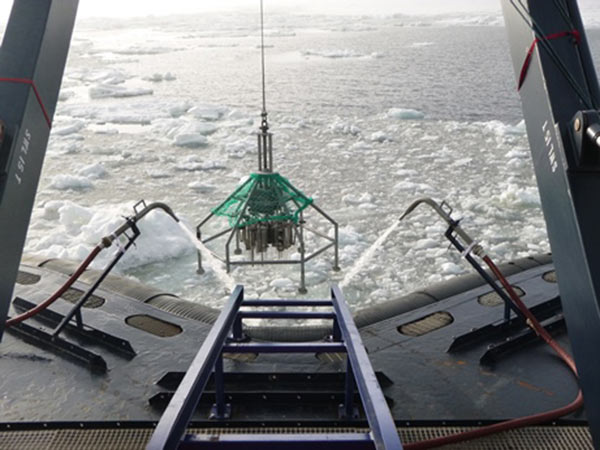|
And suddenly there was this burst of activity! When we got to our first station last Tuesday things started rolling. (Now I just had to check how long ago that was, feels as if it was longer than only a week. The feeling for time gets a bit strange here.) Everything went surprisingly well. The first two stations were still in the ice, which was a bit of a concern for the crew, because when we hang things over the reeling, like the CTD rosette for water samples or the Multicorer to collect sediment, there is a chance that big drifting ice sheets cut the wires and we lose valuable equipment. On the aft deck (back of the boat where all the sediment sampling takes place) Oden has special fire hoses that are used to flush the ice away which clogs up behind the ship. Unfortunately, some of those sheets are still bigger than a standard Swedish summer house and are too heavy to just be pushed aside. This happened at the first station, where we could do nothing but wait for the biggest blocks to float by. But a few hours later, we held the first sediment cores in our hands, coming up from underneath 3000m of water! Many happy faces everywhere!
After the second station we were suddenly back in open water. Luckily, it has been very calm so far, but still the ship is moving more than in the ice. For sediment sampling that means, that the heavy device we use – the Multicorer ways up to 800kg can start to swing and potentially slam into the ship and get damaged. Here, once again, Oden’s crew has proven to be invaluable. As usual, they carefully assess the situation and potential risks for both scientists and equipment and come up with a strategy for a safe operation. In this case it meant an extra person helping out with deploying and retrieving the sediment corer. This extra person turns out to be me. Assisting the sediment crew had been one of my tasks from the start, but now this part has become even more important. So far, we have had enough time between sampling stations for me to get my analyses in the lab done in parallel. I have already collected quite a bit of good data and got into some kind of a routine with only smaller changes every now and then: so far, so good!

The fourth day of sampling (Friday) started with some excitement: methane bubbles! The area was known from previous expeditions to feature hotspots where methane is released, that was exactly the reason why we had decided to come here. Since then, we have been on the methane hunt: with geophysical surveying of both seafloor and the water column above those locations with very high methane activities are detected and then will be decided where exactly to take samples. This procedure of course requires a lot of flexibility from all participants, as we cannot plan in advance. All affected work packages have therefore developed general watch schemes: who is “on duty” at what time during the entire day. Then the bridge knows whom to call when we are getting close to the next station and does not wake the wrong people. The crew places importance on scientists’ sleep, because being too tired while working can of course be dangerous for everyone involved. And since we will very likely have a sediment sampling station in the middle of the night during my shift, I will take a nap now – on captain’s orders.
P.S: "Middle of the night" refers to UTC, the ship's time, which seems to be far off from the local time by now. Of course, the sun never goes down here during this time of the year, but still it feels like the "afternoon" is the darkest time of the day with the worst weather; in the "evening" and "early morning" the chances of seeing the sun have been the highest during the past week.
|















